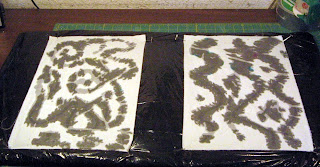I let the fabric rest for awhile, then hung to air dry. I had a craft show this weekend, so wasn't able to add the dye until Monday. Below is the fabric back on the project board, ready to be dyed.
I wanted to see what kind of results I would get with both thickened and un-thickened dyes.
I happened to have both already mixed in Aqua Marine and Bright Green, so I decided to use them for my experiment. The un-thickened dyes are on the left, the thickened are on the right. The color difference is due to the fact that I mix my thickened dyes darker than my regular dyes. I used a foam brush to paint on the dyes in both cases. Then I covered with a plastic bag and allowed to 'batch' for about 4 hours before I removed the fabric and hung to dry overnight.
This morning, I pre-soaked the fabric in warm water with synthrapol for about 20 minutes to dissolve the sugar resist, then washed in hot water and synthrapol. Here are the pieces after they dried:
I didn't know what to expect, and I'm very pleased with the outcome! There are areas where the resist was more complete, but even in the areas where the resist bled out, there is still a softer resist, which gives the pieces more depth and visual interest in my opinion. I would definitely use this method again, especially now that I have a better idea of how it resists the dyes!





Great results, Judy! Your pieces illustrate one of the benefits of sugar syrup - that soft, ethereal quality.
ReplyDeleteI like the soft edges on your pieces. Good experiment.
ReplyDeleteI really like these -- I think I need to experiment more with this.
ReplyDelete